![]()
![]()
![]()
Use LEFT and RIGHT arrow keys to navigate between flashcards;
Use UP and DOWN arrow keys to flip the card;
H to show hint;
A reads text to speech;
43 Cards in this Set
- Front
- Back
- 3rd side (hint)
|
Anton Von Leeuwenhoek? |
First to use the microscope, didn't know the organisms in pond water were bacteria. |
|
|
|
Robert Hooke? |
Examined cork slices under microscope called box-like structures cells; it stuck, although they were dead cells |
|
|
|
Matthias Schleiden? |
All plants are made of cells |
|
|
|
Theodor Schwann? |
All animals are made of cells |
|
|
|
Rudolf Vrichow? |
All new cells arise only from existing cells. |
|
|
|
Cell Theory? |
1. All living things are made of cells. 2. Cells are the basic unit of structure of cells function. 3. New cells are produced by existing cells |
3 |
|
|
What does the shape determine? |
The function of the cell. |
|
|
|
They range in size from ___ meters to ___ micrometers. |
2, 2 |
|
|
|
Cells that look alike group together in a mass called a ________. |
Tissue |
|
|
|
Prokaryotic Cell? |
-no nucleus (has DNA) -no membrane (bound organelles) -2 kingdoms: Archeabacteria, and Eubacteria. |
|
|
|
Eukaryotic Cell? |
-membrane bound nucleus -membrane bound organelles -4 kingdoms: Protista, fungi, plantae, animalia |
|
|
|
All cells must have: _________, ____ ____________, ________ ________, _____________. |
Cytoplasm, cell membrane, genetic material, ribosomes |
|
|
|
Plant cells? |
Cell wall, large vacuole, prokaryotic, photosynthesis |
|
|
|
Animal cells? |
No cell wall, no vacuole, eukaryotic, lysosomes used for waste |
|
|
|
Archebacteria? And Eubacteria? |
A: found in harsh environments E: most bacteria fit into this |
|
|
|
Multicellular cells... |
Consists of more than one cell and have several organ systems |
|
|
|
What are the parts of bacteria? |
Prokaryote, unicellular, singular~circular, chromosome, cell wall, cell membrane, ribosomes, flagella or cilia, some are surrounded by a capsule. |
|
|
|
Bacterial Shapes? |
1. Cocci-round 2. Spirilla-spiral 3. Bacilli-rod |
|
|
|
Bacteria Arrangements? |
1. Diplo- pair 2. Staphylo-cluster 3. Strepto-chain |
|
|
|
Bacteria is important for... |
Food production, nitrogen fixation, decomposer, digestion, medicine. |
|
|
|
Antibiotics have their own mode of ______ specific to how the drug inhibits or destroys bacteria. |
Action |
|
|
|
From Antibiotics: i. ii. iii. |
1. They destroy cell walls and cause cells to burst 2. Inhibits cells ability to make proteins 3. Inhibits cells ability to replicate DNA. |
|
|
|
They aren't living cause they cannot store not create ________ and also, they cannot ____________ outside of a host cell. |
Energy Reproduce |
|
|
|
Lytic Cycle? |
Reproduction occurs, cells burst |
|
|
|
Cytoplasm? |
Transparent colloid that surrounds the organelles, mostly water (like jello); is in constant motion called "cytoplasmic streaming" |
|
|
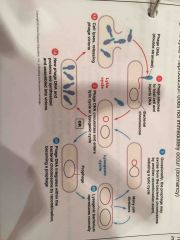
What is this? |
The viral reproduction (lytic and lysogenic) |
|
|
|
Endoplasmic Reticulum? |
-folded sacs and tunnels used as a transport system -"Rough" is covered in ribosomes; functions in protein transport -"Smooth ER" has no ribosomes; functions in cholesterol synthesis and breakdown, fat metabolism and substance detoxification. |
|
|
|
Golgi Body? (Complex, Apparatus) |
- packages cell products for release; these packages travels to the plasma membrane and the contents are ejected to the outside of the cell. |
|
|
|
Mitochondria? |
ATP ( the high-energy molecule) is made here using glucose; active cells such as muscles have thousands of mitochondria. |
|
|
|
Lysosomes? |
-small and spherical bodies which contains hydrolytic enzymes for digestion of old cells or waste or foreign particles |
|
|
|
Cytoskeleton? |
-protein structures in internal framework that determines cell shape, supports other organelles, and provides for various types of cellular movements. |
|
|
|
Cilli or Flagella? |
"Hairs" or "tail" used for locomotion. |
|
|
|
Nucleus? Nuclear Envelope? Nucleolus? |
Nucleus: Controls the center of the cell; contains DNA and controls cell division. Nuclear Envelope: membrane that surrounds the nucleus and contains pores for transport of materials outside of the nucleus. Nucleolus: darkly stained area of nucleus, ribosomes are made here |
|
|
|
Centrioles? |
They are not rod shaped bodies that lie right angles to each other; made up of fine microtubules; during cell division they direct the formation of my mitotic spindle fibers. |
|
|
|
Lysogenic Cycle? |
Reproduction doesn't immediately occur (dormancy) |
|
|
|
Vacuoles? |
Stores water, nutrients, etc. |
|
|
|
What is the "field of view"? |
The diameter of the circle of light that you see when looking into a microscope |
|
|
|
If 50x was the magnification... What would be the total magnification? |
500x |
|
|
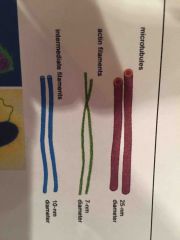
Cytoskeleton? |
-protein structures in internal framework that determines cell shape, supports other organelles, and provides for various types of cellular movements. |
|
|
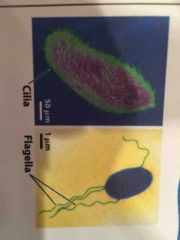
Cilli or Flagella? |
"Hairs" or "tail" used for locomotion. |
|
|

Nucleus? Nuclear Envelope? Nucleolus? |
Nucleus: Controls the center of the cell; contains DNA and controls cell division. Nuclear Envelope: membrane that surrounds the nucleus and contains pores for transport of materials outside of the nucleus. Nucleolus: darkly stained area of nucleus, ribosomes are made here |
|
|
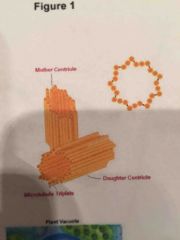
Centrioles? |
They are not rod shaped bodies that lie right angles to each other; made up of fine microtubules; during cell division they direct the formation of my mitotic spindle fibers. |
|
|
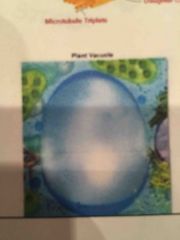
Vacuoles? |
Stores water, nutrients, etc. |
|

